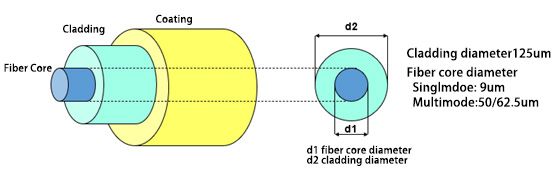Fiber Structure
Fiber is the abbreviation for optical fiber, it is made of glass (silica) that can be used as a light conducting tool. Its structure is shown in the figure: The inner layer is a fiber core with a high refractive index, used for transmitting light; the middle layer is a cladding with a lower refractive index, forming a total reflection condition together with the fiber core; the outermost layer is a protective layer used to protect the optical fiber.

Classification Of Optical Fibers
According to the number of modes transmitted in the light, optical fibers can be divided into single-mode fiber SMF and multi-mode fiber MMF.

Optical Wavelength
The essence of light is electromagnetic waves, and visible light waves are a small band in the electromagnetic spectrum, with a wavelength range between 380nm and 780nm, belonging to the infrared band; 800nm-900nm are short wavelengths; 1000nm~1800nm are long wavelengths. But so far, the most commonly used wavelengths in light are 850nm, 1310nm, and 1550nm wavelengths.

Fiber Optic Communication Operating Band
The current single-mode fiber transmission bandwidth can range from 1260nm to 1675nm, with a total width of 415nm. Generally, this 415nm width is divided into six bands: O, E, S, C, L, and U. The specific division method is as follows:
| Band | Band name | Wavelength range |
| O | Original wavelength | 1260~1360nm |
| E | Extended wavelength | 1360~1460nm |
| S | Short wavelength | 1460~1530nm |
| C | Conventional wavelength | 1530~1565nm |
| L | Long wavelength | 1565~1625nm |
| U | Ultra-long wavelength | 1625~1675nm |
Currently, most countries use fiber optic communication in the C and L bands, and only a small portion of them are used, with most frequencies remaining unused.
The Three Windows of Fiber Optic Communication
Short wavelength window, with a wavelength of 850nm
Long wavelength window, with wavelengths of 1310nm and 1550nm
At a wavelength of 850nm, the loss is about 2dB/km, and at a wavelength of 1310nm, the loss is 0.35dB/km; The loss at 1550nm wavelength is 0.20dB/km.

Fiber Optic Loss
Fiber loss is an important indicator of fiber optic transmission, which has a decisive impact on the transmission distance of fiber optic communication. In communication, it is customary to use the unit dB to represent the loss of optical fibers.
Fiber loss coefficient: The attenuation value of the power of an optical signal per kilometer of fiber, measured in dB/km
In the 1310nm window, the loss coefficient of G.652 fiber is 0.3~0.4dB/km
In the 1550nm window, the loss coefficient of G.652 fiber is 0.17-0.25dB/km
There are many reasons why optical fibers attenuate optical signals, mainly including:
Absorption attenuation, including impurity absorption and intrinsic absorption;
Scattering attenuation, including linear scattering, nonlinear scattering, and structurally incomplete scattering;
Other attenuation includes bending attenuation, etc.
The most important one is the attenuation caused by impurity absorption.
GET IN TOUCH

